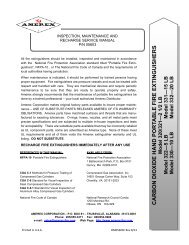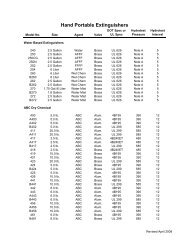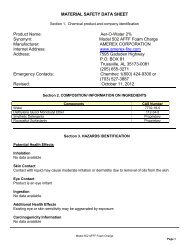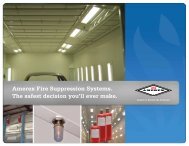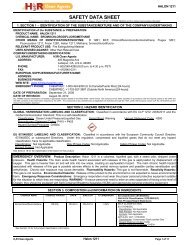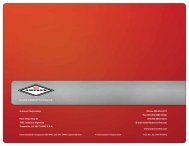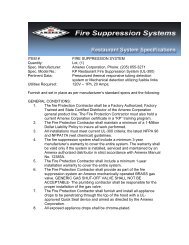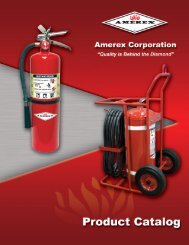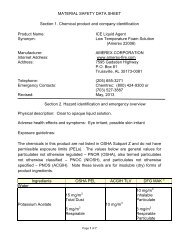Manual for 125-150 lb. cartridge operated - Amerex Corporation
Manual for 125-150 lb. cartridge operated - Amerex Corporation
Manual for 125-150 lb. cartridge operated - Amerex Corporation
You also want an ePaper? Increase the reach of your titles
YUMPU automatically turns print PDFs into web optimized ePapers that Google loves.
MAINTENANCE OF REGULATED WHEELED EXTINGUISHERS<br />
NOTE: Steps R-a thru R-d apply to models with a Regulator. These procedures should be per<strong>for</strong>med only by<br />
professionally trained and qualified service personnel thoroughly familiar with industry service procedures<br />
and safety precautions. All extinguisher and service equipment components, fittings and adapters must<br />
be in good condition and properly connected.<br />
R-a. Disconnect the regulator from the agent cylinder. Visually examine the regulator and high pressure hose<br />
<strong>for</strong> signs of damage, corrosion or deterioration. To per<strong>for</strong>m the regulator static pressure, dead set and<br />
minimum pressure flow rate checks. Connect the proper hose service kit Adapter (P/N 01740) to the low<br />
pressure outlet port of the regulator. Connect the service kit Hose Assembly (P/N 01410) and Flow<br />
Chamber (P/N 0<strong>125</strong>0) to the regulator low pressure port adapter.<br />
R-b. Make sure all service kit connections are secure and that the kit flow chamber valve is closed. Check<br />
nitrogen cylinder pressure to ensure that it is within the acceptable operating pressure range. Hold the kit<br />
flow chamber in one hand and slowly open the nitrogen cylinder (with either the “T” handle operating lever<br />
or by turning the handwheel if so equipped). Observe flow chamber pressure reading to see if it is within<br />
the specified static dead set pressure parameters noted below. The only type regulators used on <strong>Amerex</strong><br />
dry chemical regulated wheeled extinguishers were Victor and MECO. Also see <strong>Amerex</strong> Tech Tip <strong>for</strong><br />
Class D Dry Powder Wheeled Extinguisher Pressures.<br />
Regulator Type Model No. Static Dead Set Pressure Minimum Flow Pressure<br />
Victor SR-450L 225 – 245 psi 140 psi<br />
MECO P-600 235 – 255 psi 140 psi<br />
Victor SR-450E 225 – 245 psi 140 psi<br />
WARNING: IF THE PRESSURE READING EXCEEDS THE GIVEN PARAMETERS, QUICKLY<br />
CLOSE THE NITROGEN CYLINDER “T” HANDLE OR HANDWHEEL VALVE AND VENT THE<br />
PRESSURE BY OPENING THE FLOW CHAMBER BALL VALVE. REGULATORS CANNOT<br />
BE FIELD ADJUSTED – THEY MUST BE REPLACED IF FOUND TO BE OUT OF<br />
TOLERANCE.<br />
R-c. Observe the proper regulator static dead set pressure <strong>for</strong> a minimum of one minute – then fully open the<br />
flow chamber valve <strong>for</strong> 1-2 seconds and observe the pressure reading to ensure that the flow pressure<br />
does not drop below the minimum specified. Close the nitrogen cylinder valve after the test and vent the<br />
flow chamber pressure by opening the flow chamber valve.<br />
NOTE: Prior to per<strong>for</strong>ming minimum flow check, make sure that the nitrogen cylinder valve (“T” handle or<br />
handwheel) is FULLY OPEN so that it does not restrict or alter the flow readings.<br />
R-d Disconnect the service kit quick connect adapter from the low pressure regulator and reinstall the<br />
regulator securely to the agent cylinder. (THIS STEP IS FOR REGULATED EXTINGUISHERS ONLY)<br />
7. Disconnect the discharge hose from the agent cylinder. Check the couplings, hose and hose<br />
gaskets <strong>for</strong> damage or deterioration – replace as necessary.<br />
8. To per<strong>for</strong>m an operational integrity check on the discharge hose and nozzle combination:<br />
a. Connect the test kit hose adapter to the female end of the discharge hose.<br />
b. Connect the discharge nozzle shut-off lever and properly secure it.<br />
c. Connect a properly regulated and verified nitrogen pressure source (set to the<br />
extinguisher operating pressure (235-245 psi) to the test kit hose adapter.<br />
d. Slowly pressurize the discharge hose/nozzle assembly to the extinguisher operating<br />
pressure and check <strong>for</strong> leaks or distortion.<br />
6



